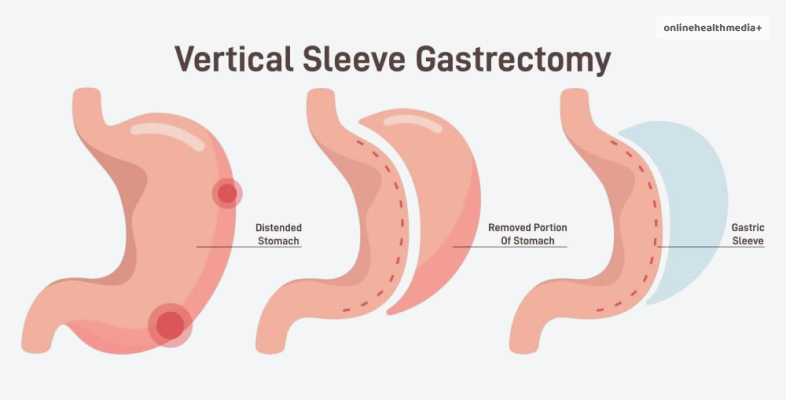Gastric Sleeve 101: Everything You Need To Know Before Going Under The Knife!
Gastric sleeve is a great option for people struggling with obesity for a long period of time. This is a surgical process where people undergo a major physiological change. Gastric sleeve, also known as sleeve gastrectomy, belongs to the bariatric surgery operation that can promote weight loss.
It is important to note that it is a cosmetic surgery that is needed when other weight loss methods have been unsuccessful. This article will elaborate on the procedure and provide information on the benefits of the surgery.
Understanding Obesity
Before we dive into the basics of gastric sleeve surgery, let us understand the “why” of people getting the surgery.
Obesity is a health state where the body stores excess amounts of fat that can pose serious risk to a person’s health. In addition, as per the World Health Organization, obesity is an “abnormal or excessive fat accumulation that presents a risk to health.”
Moreover, when the Body Mass Index is higher than 25, it fits the ‘overweight’ category and above 30 classifies as ‘obesity.’
Contrary to popular belief, obesity is more than a cosmetic concern, the stigma surrounding this condition has led to it affecting people’s mental, emotional and physical health more than the condition itself.
It is worth noting that the condition can be a result of various different types of underlying conditions. Additionally, reducing the size of the stomach helps in different ways, all of them will find a mention in the following sections.
Gastric Sleeve Explained

With the procedure being the most common weight loss surgery around the world, about 150,000 gastric sleeve surgeries are performed in the United States alone.
The number seems small in comparison to the total population- to put things into perspective, here is the total number of sleeve gastrectomies- 380,000.
However, the prognosis of the surgery is not very positive which acts as a discouraging factor for people with obesity.
Gastric sleeve bariatric surgery resembles the way a person’s stomach forms a “sleeve.” The stomach is usually cut in the vertical direction, from where it adopts the name- vertical sleeve gastrectomy. Some more facts:
- The weight loss procedure is performed through laparoscopy which includes the insertion of small instruments through incisions.
- These incisions are present in the upper abdomen which allows the stomach to undergo 80% of removal.
- Post-surgery, the stomach looks similar to a tube and resembles the size and shape of a banana.
- The surgical process can either be laparoscopy or it can be done through the use of robotics.
- The advancement in the medical surgery field has led to more positive results which has been successful in improving the patient’s quality of life.
The Surgical Process

The surgical process includes the following steps:
- Anesthesia- The surgeon puts you under general anesthesia that allows you to sleep through the procedure, minimizing anxiety or fear.
- A small incision (cut) in your abdomen allows insertion of a port. This port lets them pump in carbon dioxide which lets the abdomen expand.
- Through the port, the surgeon inserts a lighted camera which is the laparoscope. This allows them to see the abdomen properly so that they can perform the procedure.
- The insides of your abdomen are visible on a screen, facilitating visualization of the surgical site.
- Next, the surgeon proceeds to insert additional ports through one to three more cuts and complete the procedure with the help of appropriate tools.
- These tools are long and narrow so there is no fear of the procedure leaving you with bigger cuts or injury.
- The surgeon cross-checks the gastric sleeve and proceeds to separate the remaining stomach with the use of a surgical stapler.
- The rest of the stomach is cut off and the incisions are shut.
Research and Statistics

The current research points at the health improvements that have been visible in people who underwent gastric sleeve surgery.
A study in 2020 found that the procedure does not just provide an emotional boost to the patient, but it also offers several advantages. One of the few noted by them were:
- Remission of mental issues, the study noted that the gastric sleeve surgery positively influenced the individual’s mental health, reducing the mental issues. There were high chances of depression, and phobic anxiety.
- The following infographic demonstrates the changes that were present in the patient. This bariatric surgery also leads to an improvement in the sexual, psychosocial and physical quality of life.
Cost and Insurance Coverage

The cost of this surgery depends on the presence of insurance and if your insurance provider covers the surgery.
However, the average surgery cost comes down to $7,400/ $10,000 to $33,000- before the consideration of insurance coverage.
The cost of the surgery reduces depending on the insurance coverage as most insurance plans cover the cost of gastric sleeve surgery.
Additionally, if you have individual policies that can have differences in the coverage and requirements.
Benefits of Gastric Sleeve Surgery

The benefits for people include:
- Suitable for people with health conditions that do not allow them to undergo longer procedures
- Lowest risk of causing long term nutritional complications
- Provides good health benefits such as lowering blood sugar, lowering the risk of hypertensive heart disease, arterial disease and nonalcoholic fatty liver disease
- The condition also reduces the risk of obstructive sleep apnea
- The surgery can also improve and in some cases eliminate osteoarthritis and joint pain.
Potential Risks and Complications
The potential risks associated with the condition include complications such as:
- Infection
- Bleeding
- Leakage from the staple line
- Reactions to anesthesia
- Long term complications such as nutritional deficiencies, scar tissues, gallstones and gastroesophageal reflux
Life After Gastric Sleeve
The recovery after the surgery takes nearly one month to recover. There may be feelings of tiredness and fatigue.
The early weeks after the surgery restrict you to a liquid diet which may seem frustrating but it gives the body time to recover.
However, with time, the diet shifts from liquid to a soft diet and then finally, back to solid foods. The average weight loss for people undergoing the surgery is nearly 25-30%, this is just within the first one to two years. The lifestyle you adopt after the surgery also determines the percentage of weight loss.
It is important to remember that you must not go back to old habits as it increases the chance of your stomach stretching out again.
Despite there being revision surgery- gastric sleeve revision- it is best to maintain a different lifestyle that supports weight maintenance. The duodenal switch or gastric bypass become other options when you go back for a revision surgery.
Conclusion
Gastric sleeve surgery is a fairly popular procedure that is chosen for extreme cases of obesity or overweight patients.
The surgery is an option when other alternatives of weight loss have not been fruitful. The recent advancements help doctors manage the condition without the fear of medical error.
The sleeve gastrectomy is a safe and simple procedure that helps you to get rid of the excess weight and reduce health risks.
Also read
- The Best Topical Treatments For Flesh Wounds.
- Five Reasons You Should Give Up Alcohol For 2024
- 10 Things You Should Know About Having Dental Retainers.


